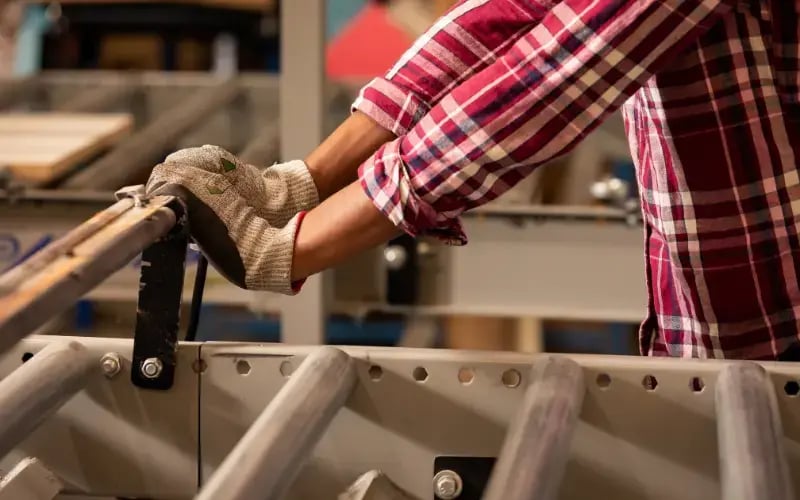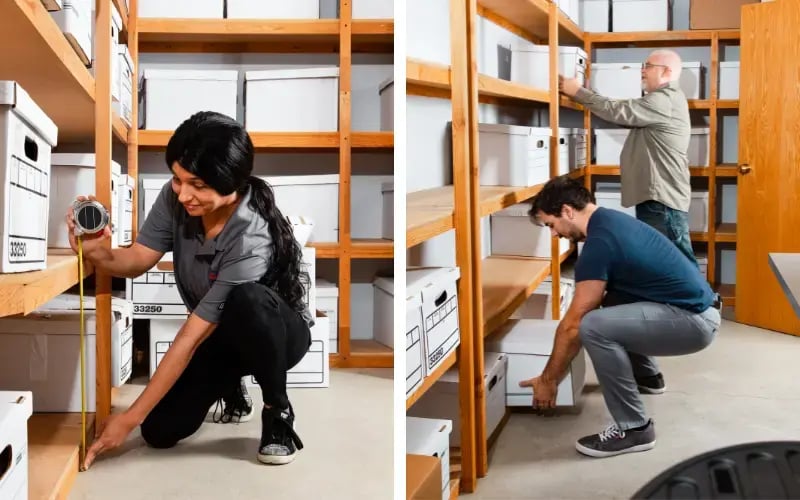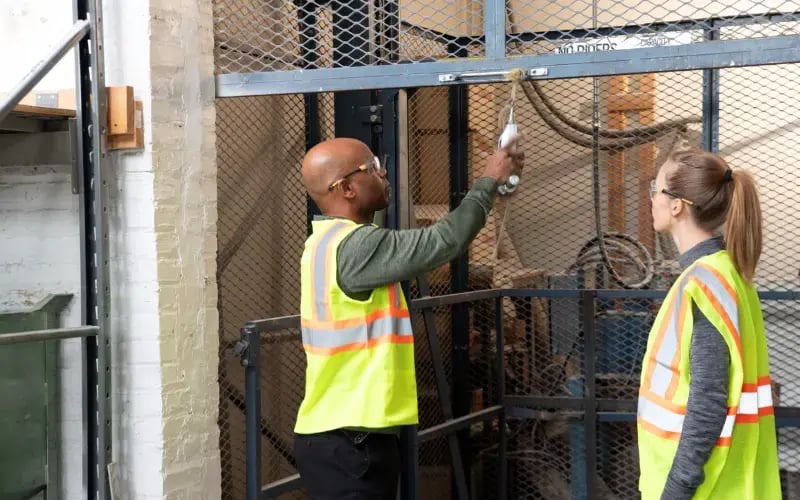Understanding the physical demands of every role within your workplace is one of the most powerful tools for improving safety, reducing injury, and fostering long-term employee satisfaction. Whether you operate in manufacturing, healthcare, warehousing, or even office settings, physical demands play a major role in musculoskeletal injury risk and rates, as well as job performance.
Musculoskeletal disorders, often caused by repetitive strain or improper body mechanics, are among the most common workplace injuries and cost businesses billions of dollars annually in healthcare expenses, lost time, and reduced productivity. Fortunately, these issues are often preventable, starting with a structured approach to identifying and managing physical demands.

4 Steps to Determine and Utilize Physical Job Demands
This guide walks through the essential steps of determining and using physical demands in your workplace, helping you create a healthier, safer, and more effective environment.
Step 1 – Understanding the Job
The first and most important step in determining physical demands is understanding the job itself. Without a clear picture of what an employee is required to do during the workday, it is impossible to create safety policies, return-to-work procedures, or job accommodations that are appropriate and effective.
This process starts with conducting a Job Analysis, a systematic process that identifies and documents the tasks, duties, responsibilities, and necessary physical and cognitive requirements of a position. Plainly, the Job Analysis determines the essential physical and cognitive functions of the job, or, the “essential functions”. Job Analysis builds a strong foundation for virtually all HR and safety functions, from hiring to training to injury prevention.
Key Questions to Ask During Job Analysis:
- What are the primary tasks and responsibilities of this position?
- Are employees lifting heavy objects? If so, how heavy are they?
- Is lifting done frequently, occasionally, or rarely?
- Are the objects lifted from the ground, at waist height, or above the shoulders?
- Are employees pushing or pulling equipment?
- Are fine motor skills or strong hand grip required?
- Does the job involve repetitive motion, awkward postures, or extended periods of standing or sitting?
It’s important to remember that these demands vary not only by industry but even from shift to shift or between different departments within the same facility. For example, a warehouse picker may have different requirements than a forklift operator, even though they’re both in logistics.
Why It Matters:
Understanding these factors ensures that you don’t underestimate the physical toll a task may take. It also empowers organizations to better match employees to jobs and implement meaningful injury prevention strategies.
More about Job Analysis: Get into the details of a Job Analysis, in this blog: What is the Purpose of a Job Analysis?

Step 2 – Identifying the Types of Physical Demands
Once the job has been fully evaluated, the next step is breaking down the different types of physical demands and how they affect employee health, efficiency, and injury risk.
Common Categories of Physical Demands:
- Lifting:
- Examples: Moving boxes to and from shelves, lifting patients, taking out trash
- Considerations: Weight, frequency, body position, need for twisting or bending
- Pushing/Pulling:
- Examples: Moving wheeled carts, operating machinery levers, sliding heavy pallets
- Considerations: Required force, surface type, need for hand or shoulder input
- Carrying:
- Examples: Transporting filled buckets, carrying trays, handling construction tools
- Considerations: Distance, terrain, grip strength needed
- Hand Dexterity and Grip Strength:
- Examples: Using hand tools, typing, sorting small items, turning valves
- Considerations: Duration of use, precision required, force applied
- Postural Demands:
- Examples: Bending, kneeling, squatting, climbing ladders
- Considerations: Duration, whether posture is static or dynamic, recovery time
- Repetitive Motion:
- Examples: Assembly line work, scanning items, data entry
- Considerations: Frequency, variation of task, time spent on the motion
Each demand has its own impact on the body. When these demands are underestimated or improperly managed, they can lead to fatigue, injury, or long-term musculoskeletal problems.
Addressing unseen impacts, like those introduced by the cognitive demands of a job, are also essential. A complete job analysis will bring together both the physical and cognitive demands of a job to give you the fullest picture of your workplace possible,
Why It Matters:
Understanding specific physical demands allows safety professionals, supervisors, and HR teams to recognize early risk factors and plan accommodations, work rotation schedules, or equipment changes to prevent strain and injury.
More about Physical Demands: Watch our 19-minute podcast on YouTube with Job Analysis expert, Ben Haynes, where he shares use cases for and effectiveness of Physical Demand Analysis (PDAs).

Step 3 – Use and Cataloguing of Physical Demands
After you’ve identified and documented the physical demands, the next step is ensuring the information is stored, communicated, and applied effectively. By determining the essential functions of a job and linking them with the objective demands of that position, employers can be the final say on what is needed for a job. This gives the employer authority over safety in their workplace and provides clear guidelines for any third party.
Storing and Accessing the Information:
A well-organized system, whether digital or physical, should house job demands information for every position. This ensures consistent access by HR, safety managers, and healthcare professionals. Consider using job demand forms or databases that break down each job into measurable, observable tasks and associated physical requirements.
Applying Job Demands in the Workplace:
- Hiring and Recruiting
Job postings and role descriptions can include physical requirements, giving applicants a clear understanding of the physical nature of the position. This transparency helps reduce turnover and increases candidate-job fit.
- Post-Offer Employment Testing (POET)
Once a candidate is selected, employers can use the documented physical demands to perform Post-Offer Employment Testing. POET ensures that employees are physically capable of performing the essential functions of the job safely, reducing early injuries, better matching individuals to jobs, and lowering workers' compensation claims.
- Injury Prevention and Job Modifications
Knowing the specific demands of a role enables you to adjust workstations, tools, and tasks to reduce ergonomic risks. For example, lowering shelf height to reduce overhead lifting or switching to carts with better handles can drastically reduce shoulder and back injuries.
- Return-to-Work Planning
After an injury, understanding the physical demands of each job can help place the employee in a position that matches their temporary restrictions. Combined with a fit-for-duty employment test, employers can use job analysis data to ensure that their workers don't return to work too soon after an injury. This is vital in preventing reinjury, reducing lost workdays, and improving morale.
Why It Matters:
Documentation is only powerful if it’s used. Integrating physical demands data into your daily operations helps you proactively prevent injuries and improve both short- and long-term workforce outcomes.
Need a better solution for storing and using your Job Demands? JOBABLE is an interactive job catalogue solution that makes hiring and return-to-work challenges disappear. > More about JOBABLE
Step 4 – Improve Over Time
Once your organization has implemented physical demands tracking and applied it to hiring, testing, and return-to-work programs, you can shift focus to continuous improvement.
Strategies for Long-Term Improvement:
- Regular Job Reviews: As processes and tools evolve, so do job tasks. Re-analyze jobs annually or when major changes occur.
- Training for Supervisors: Train leaders on recognizing signs of strain, understanding physical demands, and facilitating early reporting.
- Employee Feedback: Encourage employees to share challenges and potential improvements in their tasks. Workers often know best where the strain comes from.
- Injury Trend Analysis: Use data from near misses, injury reports, and absence records to identify high-risk areas that may benefit from intervention.
Over time, improving your workplace through ergonomic adjustments, safer task design, and better alignment between physical capacity and job demand helps reduce injuries, improve retention, and foster a culture of health and safety.
Why It Matters:
A workplace that adapts and improves is more resilient. By regularly evaluating and enhancing physical demands information, you create a cycle of prevention, not reaction.
Understanding physical demands in the workplace is not just about checking off boxes for compliance, it’s about building a better workplace from the ground up. From hiring stronger candidates and reducing early injuries, to supporting employees during return-to-work efforts, a strong understanding of job demands gives you the foundation to act strategically.
Employers who invest in job analyses, physical demands documentation, and practical applications are more likely to see reduced injury rates, improved employee satisfaction, and lower healthcare costs. It’s a win-win for businesses and their people.
So, take the time to analyze, document, apply, and improve your understanding of physical demands. In doing so, you’re not only protecting your workforce, you’re building a healthier, more productive future.
Want to maximize the benefits of a Physical Demands Analysis? Look no further than our Job Analysis services. Our team of experts will help you uncover the exact physical and cognitive demands of a job or task, providing crucial information for both employers and employees.